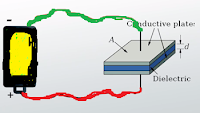Capacitance: Capacitance is the ratio of the change in an electric charge in a system to the corresponding change in its electric potential. There are two closely related notions of capacitance: self capacitance and mutual capacitance. Any object that can be electrically charged exhibits self capacitance. A material with a large self capacitance holds more electric charge at a given voltage than one with low capacitance. The notion of mutual capacitance is particularly important for understanding the operations of the capacitor, one of the three elementary linear electronic components (along with resistors and inductors).
Capacitor: Capacitor is a passive two-terminal electrical component that stores potential energy in an electric field. The effect of a capacitor is known as capacitance. While some capacitance exists between any two electrical conductors in proximity in a circuit, a capacitor is a component designed to add capacitance to a circuit. The capacitor was originally known as a condenser.
Capacitance & CapacitorTutorial Includes :1. Capacitance 2. Capacitor formulas 3. Factors governing capacitance of a conductor 4. Capacitance of an isolated spherical conductor 5. Potential energy of charged conductor 6. Similarity between a capacitor and spring 7. Sharing of charge between two conductors at different potentials 8. Capacitor and its principle 9. Factor on which capacitor of a capacitance depends 10. Significance of capacitor 11. Charging and discharging of capacitor 12. Capacitance and potential of a capacitor 13. Specific inductive capacity 14. Different types of Capacitors 15. Calculation of capacitance of a parallel plate capacitor 16. Series Combination of capacitor 17. Parallel combination of capacitor 18. Energy stored in charged capacitor 19. Energy stored in series and parallel combination of capacitors 20. Force between the plates of the capacitor 21. Van-de-Graff generator 22. Mathematical Problems of Capacitance and Capacitor 23. Question Answer Notes for Capacitance and capacitorWhat is Capacitance?
Capacitance or capacity of a conductor denotes its ability to hold charge. This ability of a conductor depends on its sizes, shapes, medium and presence of other conductor near it. When a conductor is given a charge its potential rises. It is found that rise of potential is proportional to charge imperted. So if V be the rise of potential of a conductor due to a charge q given to it, then \[q\varpropto V\]
The constant of proportionality is called the capacitance of the conductor.
Definition of C (capacitance) : If in the relation q=CV we put v=1, then q=C.
Hence, the capacitance of a conductor is numerically equal to electric charge required to raise the potential by one unit.
Units of Capacitance: In SI system, unit of capacitance is Farad (F). It is also taken as practical unit of capacitance.
A conductor is said to have capacitance of one Farad, if one coulomb charge raises its electric potential by one volt.
i.e. 1 F = 1 C. V-1
In c.g.s system, unit of capacitance is statfarad.
A conductor is said to have capacitance of one statfarad, if one-statcoulomb charge raises its potential by one statvolt.
i.e. 1 Statfarad = Stat Coloumb/stat volt
Relation between Farad and Statfarad: 1F = 1C/1V = 9 x 1011 Statfarad.In practice following smaller units of capacitance are also used : microfarad(10-6), picofarad(10-12)
Capacitance of a conductor depends on the following factors :
- Surface area of the conductor : If the surface area of the conductor is large, for a given charge, its potential will be smaller. As \(C \propto \frac{1}{V}\) (fixed charge), so the capacitance increases.
- Proximity of other conductors : If another conductor is kept near the given conductor, its rise of potential is less due to a charge given to it. So its capacitance increases.
- Nature of the sorrounding medium : The capacitance of a conductor depends on dielectric constant K (\(K = \frac{\varepsilon }{{{\varepsilon _0}}}\)) of the medium. Higher the value of K higher is capacitance of the conductor.
What is Capacitor?
A capacitor is a passive two-terminal electrical component that stores potential energy in an electric field. The effect of a capacitor is known as capacitance.
Factors governing the capacitance of a conductor
- The area of the conductor : The potential of a conductor decreases with the increase of the surface area of the conductor ; hence its capacitance increases.
- The medium surrounding of the conductor : If air surrounding the conductor is replaced by any non-conducting medium like paraffin, sulphur, glass etc., the capacitance of the conductor increases.
- Presence of earth-connected conductor : If another conductor (uncharged) is placed near the charged conductor under test, specifically if the uncharged conductor is earth-connected, capacitance of the charged conductor under test increases remarkably.
- Capacitance of a spherical conductor is directly proportional to its radius.
- The above equation is true for conducting spheres, hollow or solid.
- If the sphere is in a medium, then C = 4πε0εr.R
- Capacitance of the earth is 711 μF.
Capacitance of an isolated sperical condcutor
Let us consider a Spherical conductor . Point out its center as 'O' and radius 'r'. Give some positive charge say 'q' to charge the conductor. When we will give the charge to the conductor it will start spreading equally over its outer surface. Charge spreading does not depend upon the type of conductor used. One can take both hollow as well as solid conductor. Charge spreading will be same. If the charge spreading will be uniform then the potential will be also uniform.
V = q/4πε0r => C = q/v => C=q4πε0r/q => C=4πε0r
We know earth is spherical. So putting the values according to the earth in the above equation.
Lets take the radius r=6400 Km.
So, it becomes 6.4 X 10 6 m.
After substituting the values :
C= Electrostatic figure 2.55 X r
= 6.4 X 10 6/9 X 10 9
=0.711 X 10 -3 farad.
So the value after calculation will be 711 uF.
It is clear from the result that the capacity of the earth is 711 microfarad. The amount 711 farad is very large. Due to such a large capacitance, earth has the ability to carry infinite amount of charge.
Units
In esu unit : V = Q/R => C = Q/V = Q/Q/R = R (esu)
In esu unit : V = Q/R => C = Q/V = Q/Q/R = R (esu)
i.e., the capacitance in esu of an isolated spherical conductor placed in air is numerically equal to its radius in cm.









0 Comments